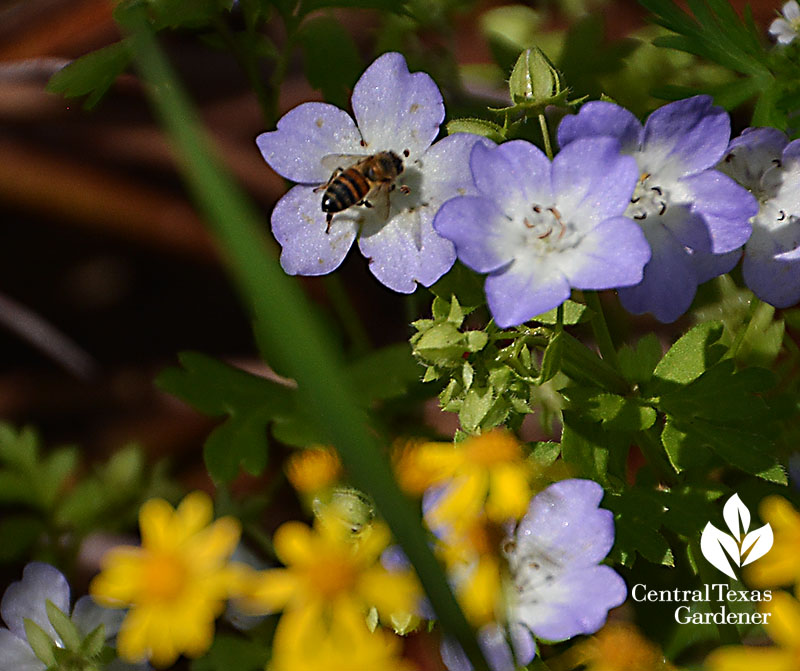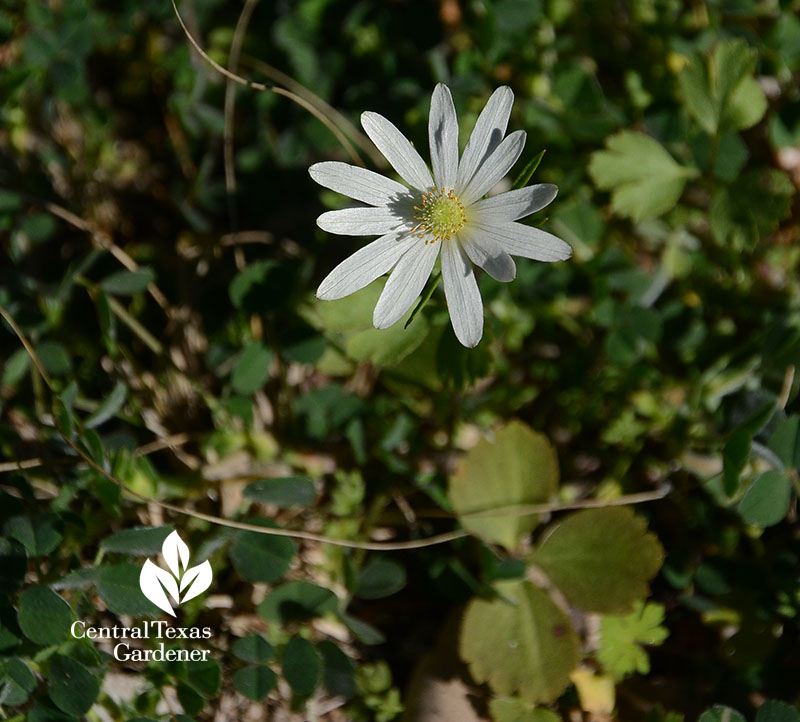February 28, 2019
Every season, my garden thrives in drought
Long ago, I admired tidy Leucojum aestivums circling beds and trees in older neighborhoods. Finally, I got a few of my own that I’ve divided over and over for romantic flower droplets starting every February.

Commonly called “Summer Snowflakes,” ours bloom in late winter/spring, though often it sure feels like summer as it did this week! My dear sunbathing cat Sam Jr. is gone, but those Leucojums have filled in even more to swing attention from the cut-back native perennial Turk’s caps beyond.

When the old tree stump rotted away, I replaced it with an angular container I turned upside down.

Sam never tried to eat or chase the butterflies and hummingbirds that feed on almost-never-watered Turk’s cap.

I call this picture “Sun and Earth,” a whimsical shot on Sunday morning of my passalong Grandma’s Flag white bearded iris.

To counterpoint the iris’s regal stance, Narcissus ‘Abba’ is cheerfully rounded, always returning in my dry, clay soil.

My white, fragrant Lady Banks rose usually lags behind the yellow one on the other side of the yard, but this week it popped one fluffy little flower. Perhaps it wanted to give me credence for connecting a color scheme across the yard. Actually, it was happenstance. I plant for the site, not necessarily the color.

The real surprise is the bulbils that showed up on the flower stalk of my Mangave ‘Bloodspot’. The background is our patio plastic since this one suffers for me in wet, winter ground. I keep in a container where in summer I can protect it from rain bombs and sun scalds.

Last September, it sent out a tall flower.


I didn’t cut the stalk after flowering, hoping to reap seeds. Instead, I’ve got 15 more mangaves to pass along! Also, unlike some agaves, mangaves don’t die after flowering.

I’m so glad that Melissa Sinclair Stevens shared her native Baby Blue Eyes (Nemophila menziesii) a few years back. These cuties self-seed in part shade.

Combined with yellow columbine or this golden groundsel (Packera obovata), you’ve got a showstopper, especially for bees.

Follow the Lady Bird Johnson Wildlflower Center’s Texas Wildflower Watch on Instagram @TexasWildflowerWatch for updates on what’s blooming where in the unveiling weeks to come. Tag your photos #TXWildflowers2019. I spotted windflowers (Anemone berlandieri) this week on a Burnet roadside.

So what about our merry-go-round weather? This year reminds me of 1996 when we hit a record 99° on February 21, 1996. I remember the date since we had a big family event at the time.

I used to keep a hand-written garden diary (even when I got a computer) to note seasonal swings and document my garden growth. Honestly, now it’s history almost as valuable as my grandparents’ photo albums and journals.
Anyway, after that record heat, on the first day of spring in 1996, we went cold again on March 1. And now we’re expecting a freeze early next week after our warm temps.

This entry’s a real hoot: “Drought predicted through 1999.”

As we now know, drought is here to stay between dramatic storm events. Gradually, we’ve changed our planting ways, and I’m so glad and honored that CTG—and YOU—have been a part of that process.
In case you missed it, this week we repeat our interview with introspective Flora Grubb, a native Texan
who grew up with drought swings. When she moved to San Francisco and launched Flora Grubb Gardens, she took along her respect for diminishing water resources.

On a trip back to Texas last spring, she joined us to explore stylish, water thrifty design philosophy as drought’s become a way of gardening life.

Watch now!
Thanks for stopping by! Linda

